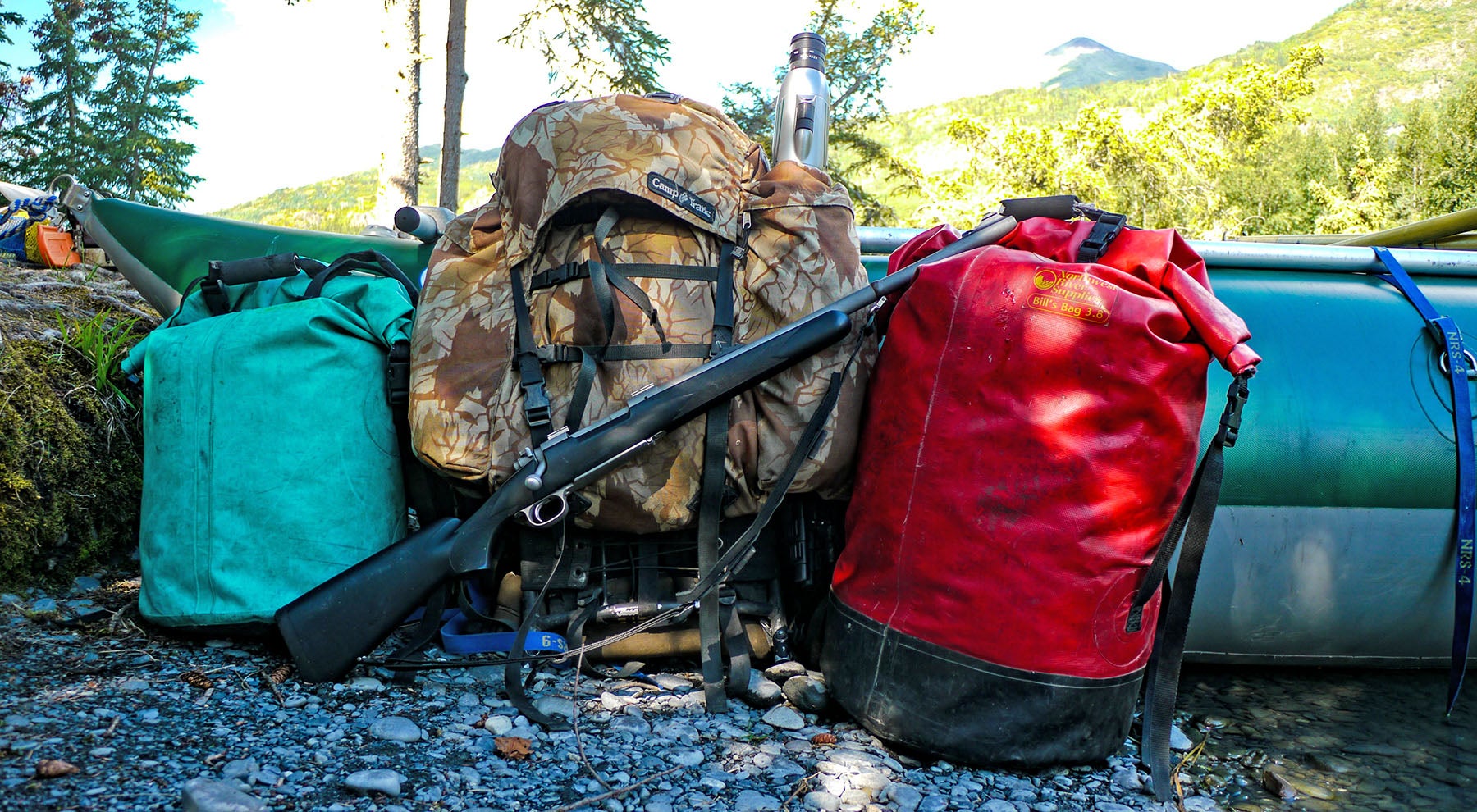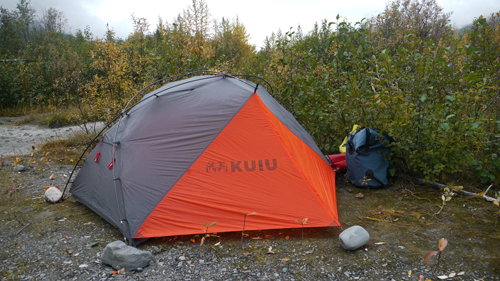
Gearing up for an Alaska hunt is no small matter. An Alaska hunt will test the limits of even the best equipment money can buy, and a gear failure can have disastrous consequences. You need rain gear that provides adequate ventilation but doesn't leak. Tents must be able to handle gale-force winds without leaking and without the poles snapping and lacerating your rainfly. Sleeping bags must be light-weight and warm. Backpacks must be rugged enough to handle heavy loads of meat, rafts, and other equipment.
Take it Slow
Most of the best gear comes at a high price, and most of us don't have an unlimited balance in our checking account. Take your time outfitting yourself, and you will get there soon enough. Start off with equipment that can get you by for a few seasons until you can do the proper research and save up for the best. You won't regret it.
The Basics
All Alaska hunters should have some basic items to start with, regardless of what kind of hunting they're doing, in which part of the state. Here are some ideas:
Headgear
You'll lose a lot of heat through your head and neck because you have a lot of capillaries in those areas. Cover your head with a good hat, and your neck with either a neck gaiter or a balaclava; a stocking cap with a face hole, and a sleeve that covers your neck. The balaclava can be cinched down to hold a baseball cap down in strong winds. Ball caps are great for keeping the sun off your face, but the wind can sail them away over the horizon if they're not secured with a balaclava. Stocking caps are good, as well, but they don't cover the neck area.
Clothing
You'll need a couple of sets of good thermal underwear for the fall hunting season. Good fabrics are wool/poly blends or polypropylene. Stay clear of cotton! If it gets wet, the fibers mat down and it loses its thermal efficiency. Regular tee shirts and underwear should also be made of synthetic fiber. Socks should be synthetic or a wool / synthetic blend. You'll also need a couple of rugged long-sleeved shirts. Worsterlon is an excellent material, and it wears like denim. Fleece is also good. Nylon and polyester are good choices as well. Go with similar fabrics for your pants, and go with zippered pockets if you can get them. Nothing worse than losing your lighter because it slid out of your pocket when you sat down to glass.
Raingear
Breathable raingear is mostly a waste of money, as it tends to leak at the seams after two or three hunts. Instead, go with a rugged 100% waterproof membrane like rubberized coatings on nylon, or urethane coated nylon. Go with a smooth surface so you can make your close stalks in silence. Coated Cordura nylon is too noisy for that kind of work. Ensure that your rain jacket is vented adequately in order to prevent excessive buildup of moisture from sweat and condensation. Rain pants should have leg zips to allow you to put them on and take them off over boots, without having to remove your footwear.
Footwear
Some hunters opt for leather boots, knowing that they will get wet and be impossible to dry in field conditions. Others prefer synthetics because they dry quickly. Whatever you choose, you want good ankle support. Sheep hunters may opt for synthetic climbing boots that lock the ankle to prevent it from turning at an inappropriate time. This is especially true for hunters with weak ankles.
If you're hunting Southeast Alaska a lot, a pair of calf-length rubber boots are essential. If you have weaker ankles, you should know that these boots offer little in the way of ankle support, so you'll want to tape your ankles with an ACE bandage or something similar.
Gloves
Bring a lightweight pair of synthetic gloves to cover your hands if the mosquitoes and whitesox are out. Unprotected hands will become targets for these blood-sucking insects, and some folks have an allergic reaction to bug bites. For additional warmth, choose a pair of waterproof insulated gloves that fit over your glove liners. Some hunters prefer gloves that offer a way to get a trigger finger out without removing the gloves. If you can't find those, use fingerless gloves over your liners. Finally, in very cold weather, you might consider a waterproof mitten shell.
Sleeping Gear
If you don't sleep well, you won't hunt well. Pay careful attention to your sleeping gear and it will pay off in greater vigilance on the spotting hill, and a higher success rate.
Sleeping Bags
There are two primary considerations when it comes to sleeping bag materials: the shell, and the fill. Go with a nylon shell, not canvas or cotton. Some Alaska hunters prefer down-filled bags; they're among the lightest, most compact sleeping bags on the market. But if it gets wet, down mats down just like cotton does, and loses most of its thermal value. A coated down is available which purports to eliminate this problem. Marketed under various names, and used by some of the most respected gear companies on the market, it's worth a look. Synthetic fills will retain their thermal value when wet, because the fibers don't absorb moisture. You can actually sleep in a completely saturated synthetic bag and stay plenty warm. The downside of synthetics is weight and bulk. They just don't pack as tightly as down. A good compromise is Primaloft, a synthetic that mimics the weight and bulk of down, while keeping the thermal properties of synthetic fill.
Sleeping Pads
When you lay down in a sleeping bag, your body mats the fill material down under you. So you lose much of the thermal benefit of the bag under your body. Compensate for that by placing a pad beneath the bag. A good pad offers a level of comfort as well as providing insulation. Pads come in various types, including closed-cell pads, air mattresses, and a combination of both; a foam pad inside an inflatable shell. All are good, but the air mattresses are the most compact. Don't choose a cheap vinyl air mattress; instead, go with one made of durable urethane-coated nylon.
Cots
The purpose of a cot is twofold; first, it provides a somewhat flexible surface for additional comfort, and second, it provides a flat surface upon which you can sleep. This is very important as the ground in Alaska is often rough and uneven. Cots offer nothing in terms of thermal efficiency, and because your body flattens out the sleeping bag under you, sleeping on a cot without a pad underneath will leave you cold and miserable. So if you're using a cot, use a pad too! There are several types of cots available. Go with lightweight and compact design.
Accessories
You need a good compression sack for your sleeping bag, and there are two kinds; those that cinch from the ends, and those that cinch from the sides. Choose a side-cinch design. It turns the bag into a compact cylinder that packs easily. The other types of compression bags turn the sleeping bag into a round ball that's hard to pack.
You might also consider tossing in a stocking cap and a small flashlight into your sleeping bag for additional comfort, and so you can find your way around the tent after dark.
Other Gear
There are of course many other things you will need as you outfit yourself for Alaska hunting. Check out our pages on other gear by reviewing the Gear Menus on this page.
